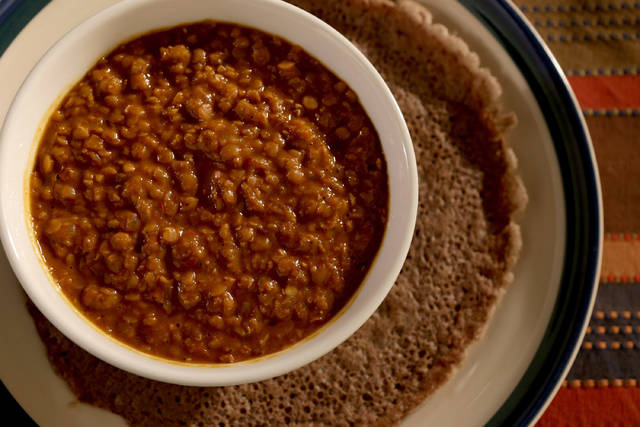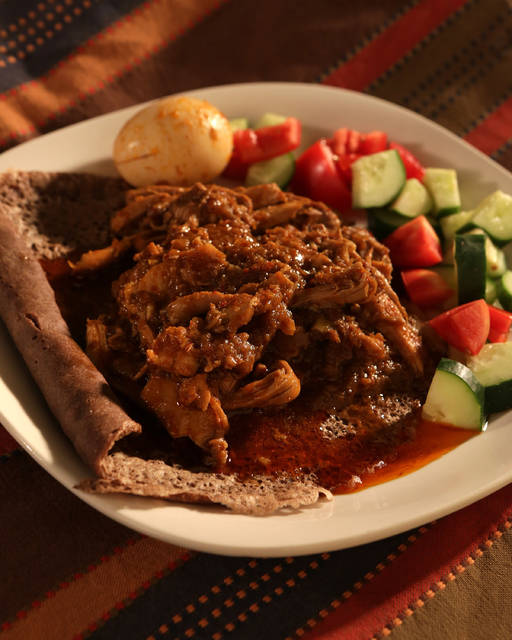Iconic Ethiopian food: Five recipes to experience at home


I still remember the first time I ever had Ethiopian food. It was at Mama Desta’s Red Sea restaurant in Chicago, where I took an ex-flame that I was desperately trying to rekindle.
I still remember the first time I ever had Ethiopian food. It was at Mama Desta’s Red Sea restaurant in Chicago, where I took an ex-flame that I was desperately trying to rekindle.
I don’t remember what we ate, but I was blown away by the expert melding of flavors and textures in the stewed meats, the rugged earthiness of the cooked vegetables and what at the time was the novelty of the spongy flat bread that tied it all together.
The impressions of that meal lasted longer than the young woman in question.
Ethiopia has been in the news recently, having successfully achieved a peace agreement with neighboring Eritrea, with which it had been in a conflict for two decades. The countries have opened embassies in each other’s capitals, and air travel has been restored.
What better time, then, to take a look at Ethiopian cuisine? The food that first thrilled me more than 30 years ago is as marvelous as it ever was — and you can make it at home. After all, they do in Ethiopia.
But I have to admit, Ethiopian food can take a while to make. And before you start, you may have to make a couple of essentials that all Ethiopians keep in their kitchens.
Still, the magical melange of flavors that can only be created through this time and effort are well worth the trouble.
One more caveat: You are going to have to go to an international market, or a specialty store at the very least, to do it right. There is really no way around it.
I decided to make three of Ethiopia’s most iconic dishes: the chicken stew called Doro Wot, which is sometimes called the national dish of Ethiopia; a vegetarian lentil stew called Mesir Wot; and the ubiquitous bread you use to eat both dishes and most Ethiopian food, Injera.
First, however, I had to make a couple of ingredients that would be used in the wots (stews).
Berbere is a blend of spices — the version I made had 14 ingredients in it — that is essential to many Ethiopian recipes. It is like the country’s approach to cooking in miniature: It blends a great many ingredients into a holistic, robust combination that is better than the sum of its parts.
I also made Nit’r Qibe, a spiced, clarified butter. Again, this version had 14 ingredients, but they all come together to make something quite unlike anything else I’ve ever had. It’s the flavor of Ethiopia.
Although whipping up a batch of Berbere or Nit’r Qibe will leave you with more spices or spiced butter than you need for the immediate recipes, you can save them both for so many other uses. Eggs, grilled meat, baked chicken — you can even use the Berbere as a rub for barbecue, if you like it spicy.
Berbere is an integral part of the Doro Wot, and Nit’r Qibe is used in it, too. But mostly, it’s onions. Lots and lots of onions. I used five, and you could make a case for more. They are cooked and cooked and cooked until they are nothing more than caramelized texture.
Garlic and ginger go in the pot, too, along with a healthy dose of Berbere. You cook that down even more before you add an also-healthy dose of Nit’r Qibe. Only then do you add the chicken. And only when the chicken is finally done do you add hard-cooked eggs, which should finally answer the question about which came first.
Mesir Wot also makes considerable use of Berbere, but the resulting flavor is completely different. While the chicken stew, Doro Wot, is rich and earthy, the lentil dish, Mesir Wot, is almost sweet; the fragrant cardamom, which is sometimes used in desserts, really comes through.
Both are fairly spicy, though. If you want to tone down the heat, you could just use less cayenne pepper in the Berbere mix. That’s one advantage over buying it at the store, if you could find it.
Although Injera bread is a vital part of Ethiopian cuisine, a lot of Americans find it does not suit their palate. The texture is thin and spongy — all the better for sopping up the delicious Ethiopian sauces — and it seems to expand in your stomach. And when made right, the taste is a little sour, a little tangy.
Doro Wot
Yield: 8 servings
5 onions
1/2 cup olive oil
3 tablespoons finely chopped garlic
3 tablespoons minced ginger
Salt
7 tablespoons berbere, see notes
5 tablespoons nit’r qibe, see notes
3 pounds chicken, in pieces
4 hard-cooked eggs
Notes: Berbere is a spice mix that is available at some international markets and spice stores, or you could make it yourself with the provided recipe. Nit’r qibe is a spiced, clarified butter you can make with the provided recipe.
1. Finely chop the onions; this is easiest done in batches in a food processor. Cook onions in a large pot over medium-high heat without oil for 12 to 15 minutes, stirring occasionally. Add oil, cover and cook 20 minutes, stirring frequently.
2. Add garlic, ginger and 1 teaspoon salt. Add berbere and stir thoroughly. Cover and cook 30 minutes on medium-low heat, stirring frequently — about every 2 minutes.
3. Stir in the nit’r qibe, cover and cook 15 minutes, stirring frequently — about every 2 minutes. Add 1 cup water, cover and continue cooking and stirring for 15 minutes.
4. Season chicken with salt, and add. Cook until chicken pieces are completely cooked and tender, 40 minutes.
5. Peel hard-cooked eggs and cut a cross in the top of each one. Add eggs to pot and stir. Taste and add salt, if needed. Skim oil off top, if desired; it is especially easy if you refrigerate it first. Serve with injera bread or, untraditionally, with rice.
Injera
Yield: 7 servings
5 cups warm water (110 degrees), divided
1 teaspoon honey
1 package (2 1/4 teaspoons) active dry yeast
3 cups millet flour, see note
1 teaspoon salt
1/4 teaspoon baking soda
Note: Injera is traditionally made with teff, a grain that can sometimes be found in international markets. We used millet flour, which is available in some large grocery stores, as well as international markets. The traditional Ethiopian method, using teff, is a three-day process.
1. Place 1/4 cup of the water in a large bowl and stir in the honey and yeast to dissolve them. When the surface turns foamy, add the remaining 4 3/4 cups warm water and the flour. Stir until smooth, and cover. Allow to stand at room temperature for 24 hours.
2. Add the salt and baking soda, and stir the batter well.
3. Lightly coat a 10-inch, nonstick skillet with nonstick spray or oil. Heat over medium heat until hot. Pour 1/2 cup of the batter into the skillet, tilting and swirling the pan to coat the bottom. Cover, and cook 2 minutes or a little more until the bread has risen slightly and is dotted with holes. Remove to a platter and cool. Repeat with remaining batter, oiling pan each time. Cool each bread on a separate platter; they can be stacked once they are cooled.
Nit’r Qibe
Yield: 22 servings
1 teaspoon whole black peppercorns
3 black cardamom pods, not green, see note
3 whole cloves
1 teaspoon fenugreek seeds, see note
1 teaspoon coriander seeds
1/2 teaspoon cumin seeds
1/4 cup chopped onion
3 tablespoons minced garlic
2 tablespoons minced ginger
1 cinnamon stick
1 teaspoon dried oregano
1/4 teaspoon ground nutmeg
1/4 teaspoon ground turmeric
1 pound butter
Note: Black cardamom pods and fenugreek are available at international markets and spice stores.
1. Preheat oven to 200 degrees.
2. Toast peppercorns, cardamom pods, cloves, fenugreek, coriander and cumin over medium heat in a dry skillet, stirring frequently, until fragrant, about 2 minutes.
3. Place toasted spices in an ovenproof bowl, along with onion, garlic, ginger, cinnamon, oregano, nutmeg and turmeric. Place butter on top and cook in oven for 1 hour.
4. Skim white solids off top of now-clear melted butter. Strain through fine cheesecloth or fine-mesh strainer into another bowl, and refrigerate. When solidified, remove from that bowl, turn over, and scrape white part off what used to be the bottom. Place remainder in a bowl or ramekin, cover and store at room temperature for several weeks or in refrigerator for many months.
Berbere
Yield: 15 servings
1/2 cup ground dried New Mexico chiles, see notes
1/4 cup paprika
1 tablespoon cayenne pepper
1 teaspoon onion powder
1 teaspoon ground ginger
1 teaspoon ground cumin
1 teaspoon ground coriander
1 teaspoon ground cardamom
1 teaspoon ground feugreek, see notes
1/2 teaspoon garlic powder
1/4 teaspoon ground cinnamon
1/4 teaspoon ground nutmeg
1/2 teaspoon ground allspice
1/2 teaspoon ground cloves
Note: New Mexico chiles are available, often already ground, at international markets. Fenugreek is a spice that is available at spice stores or international markets.
Thoroughly combine all ingredients. Store in an airtight container.
Mesir Wot
Yield: 5 servings
2 medium onions, chopped
4 tablespoons oil
5 cloves garlic, minced
1/2 teaspoon ground cardamom
3 tablespoons berbere, see notes
1 cup red lentils
1 teaspoon salt, or to taste
1 to 2 pinches granulated sugar, optional
Notes: Do not use a nonstick pan for this recipe.
— Berbere is a spice mix available at international markets and spice stores, or you could make your own with the provided recipe.
1. Heat a large pan that is not nonstick over medium to medium-high heat. Add the onions (without oil) and cook, stirring frequently, to sweat out some of the moisture. When the onions are translucent, after 5 to 10 minutes, add the oil. Sauté a few more minutes, stirring frequently. Add garlic; sauté a few minutes more.
2. Add cardamom, berbere and 2 tablespoons water. Lower the heat to medium and cook 10 minutes, stirring frequently. Add more water if necessary to avoid sticking.
3. Add 1/4 cup water and the lentils. Stir almost constantly until water is absorbed. Continue adding water, 1/4 cup at a time, and stirring until it is absorbed; the idea is to let the lentils scorch on the bottom a bit each time without burning. Continue cooking in this manner until the lentils are fully cooked; you will need a total of 3 cups of water, more or less. Then top it off with enough water to give it the consistency of a thick sauce. Add salt and the sugar, if necessary.


